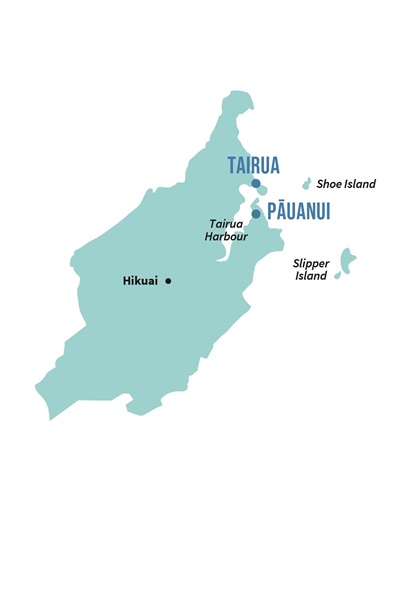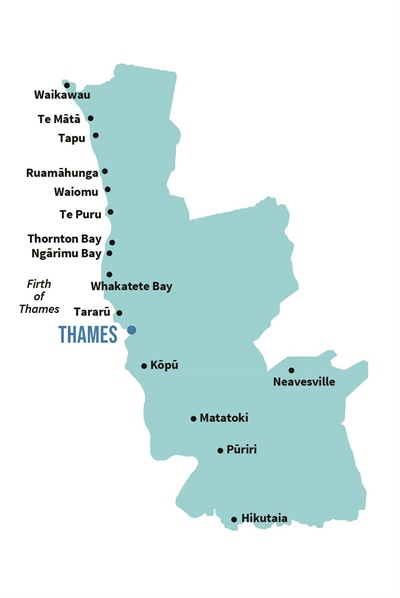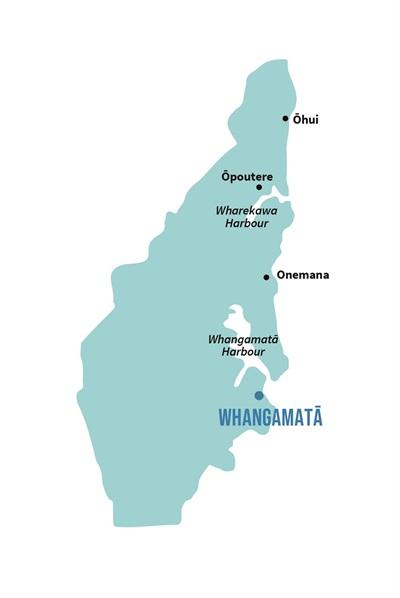2024 Representation Review

Determination of the representation review now complete
The Local Government Commission has completed its determination of the representation arrangements for Thames-Coromandel District Council, to apply for the election to be held on 11 October 2025.
The Local Government Commission released its determination on Wednesday 15 January, and decided to uphold Councils final proposal.
You can read the determination here(PDF, 195KB)
He Arotake Whakaahuatanga | Representation Review 2024
Council adopted its final proposal on 3 September 2024 for its representation arrangements for the 2025 triennial local elections. This will include the Mayor elected at large, 10 councillors elected from five wards, and a new Māori ward. Te Tara o Te Ika Māori Ward will cover our entire district and be represented by a single councillor elected from the Māori electoral roll. Our existing wards, community boards, and councillor numbers will remain unchanged.
You can view the meeting online on our YouTube channel and read the full report online here.
At the same time as the October 2025 local elections, registered voters in the district will be asked whether or not they wish to continue having a Māori Ward.
The final proposal differs from the initial proposal on one point:
- The renaming of the Māori ward to Te Tara o Te Ika Māori Ward
Read the final proposal
What was our initial proposal?
Our initial proposal reflected the status quo except for:
- an additional councillor to reflect the introduction of a Māori Ward; and
- a minor boundary change between the South East General Ward and Thames General Ward, and the Tairua-Pāuanui Community Board and Thames Community Board, that affects Neavesville Road and its surrounds.
What's the appeal/objection process?
- Any person who has made a submission on Council’s initial proposal may lodge an appeal against the Council’s decision. An appeal must relate to the matters raised in that person’s submission.
- Any person may lodge an objection against the Council’s decision. An objection must specify the matters to which the objection relates.
- Appeals or objections should state your name, address, telephone number and email address (if you have one) and should reach the Council no later than 4.00pm on Friday 25 October 2024.
Lodge your objection or appeal online here
You can also download our print friendly form here and send it to us:
- Council’s Main Office, 515 Mackay Street, Thames
- Coromandel Service Centre, 355 Kapanga Road, Coromandel
- Mercury Bay Service Centre, 10 Monk Street, Whitianga
- Whangamatā Service Centre, 620 Port Road, Whangamatā.
- By mail: Governance Services, Thames-Coromandel District Council, 515 Mackay Street, Thames or Private Bag 9001, Thames 3540.
What's the background?
At its 31 October 2023 meeting, our Council unanimously voted to establish one or more Māori Wards for the 2025 Local Elections. This is what triggered the representation review process, to make sure our communities are fairly and effectively represented at Council. The review does not revisit the decision to establish Māori Wards.
A short community survey was run from 1-31 March 2024, to help us understand how our communities feel about key aspects of our current representation structure. This feedback helped to inform our initial proposal.
Below, you'll find a drop-down menu with all the information(PDF, 1MB) on what is being reviewed.
What's the process?

Click here to download the key information guide
Key Information
What are Representation Reviews?
A representation review addresses the total number of councillors there should be for the district or region and the way they are elected.
This involves deciding whether councillors are elected from wards, or by a mix of both wards and 'at large'.
A review also covers the boundaries of wards, Community Boards and their names.
You can watch a summary of the Representation Review process below:
Why have a Representation Review?
To ensure councils retain effective and fair representation for the community, all territorial authorities are required under the Local Electoral Act 2001 to review their representation arrangements at least every six years. The last representation review was undertaken in 2021 however, as Council resolved to establish Māori Wards for the 2025 local elections, we must undertake a representation review in 2024.
Representation reviews offer a chance for us to look at the current local boards and wards to make sure that they are represented fairly and effectively.
What is our initial proposal?
The initial proposal for the district is:
- Mayor, elected at large;
- 10 Councillors (9 general ward councillors and 1 Māori ward councillor);
- 5 wards (4 general wards and one district-wide Māori ward);
-
- Coromandel-Colville Ward - Represented by one Councillor.
- Mercury Bay Ward - Represented by three Councillors.
- South Eastern Ward - Represented by two Councillors.
- Thames Ward - Represented by three Councillors.
- Māori Ward – Represented at large.
- 20 Community Board members elected from five Community Boards;
-
- Coromandel-Colville Community Board - Four Board Members and one appointed of the Council representing either the Coromandel-Colville General Ward or the Thames-Coromandel Māori Ward.
- Mercury Bay Community Board - Four Board Members and three appointed members of the Council representing either the Mercury Bay General Ward or the Thames-Coromandel Māori Ward.
- Tairua-Pāuanui Community Board - Four Board Members and two appointed members of the Council representing either the South East General Ward or the Thames-Coromandel Māori Ward.
- Whangamatā Community Board - Four Board Members and two appointed members of the Council representing either the South East General Ward or the Thames-Coromandel Māori Ward.
- Thames Community Board - Four Board Members and three appointed members of the Council representing either the Thames General Ward or the Thames-Coromandel Māori Ward.
Proposed ward and community board boundaries
The above arrangements reflect the status quo, with a minor boundary change between the Thames General Ward and the South East General Ward and the Thames Community Board and Tairua-Pāuanui Community Board, shifting the area of Neavesville and its surrounds to better reflect communities of interest.

Proposed Community Board boundaries and names
Coromandel-Colville Community Board

Mercury Bay Community Board

Tairua/Pāuanui Community Board

Thames Community Board

Whangamatā Community Board

What are wards?
Wards are areas of a district identified for electoral purposes. They work in the same way as seats in a general election.
Currently in the Thames-Coromandel we have a ward system where candidates stand in a ward area and people living in that area get to vote for them.
Our four election wards are: Thames, Coromandel-Colville, Mercury Bay and South Eastern. Currently people can only vote for candidates in their ward, but everyone gets to vote for who they want as Mayor.
Although candidates stand for their ward area, when voted on to council, councillors swear an oath to work for the district as a whole.
You can find out more about our current ward structure here: Our Wards Information.
Current Councillors and boundaries
The review would consider how many elected members are required to represent the needs of the Thames-Coromandel District Council.
The current model for the district is:
- One Mayor elected from across the district (‘at large’).
- Nine Councillors elected from four wards (Each Councillor currently represents between 3500 and 4100 residents and ratepayers.).
- Coromandel-Colville Ward - Represented by one Councillor.
- Mercury Bay Ward - Represented by three Councillors.
- South Eastern Ward - Represented by two Councillors.
- Thames Ward - Represented by three Councillors.
- 20 Community Board members elected from five Community Boards.
- Coromandel-Colville Community Board - Four Board Members and one appointed Ward Councillor.
- Mercury Bay Community Board - Four Board Members and three appointed Ward Councillors.
- Tairua-Pāuanui Community Board - Four Board Members and two appointed Ward Councillors.
- Whangamatā Community Board - Four Board Members and two appointed Ward Councillors.
- Thames Community Board - Four Board Members and three appointed Ward Councillors.
Current ward and community board boundaries

Structure for electing Councillors
What we need to consider:
The review will consider how Councillors can be elected and whether we vote for them ‘at large’, by ward system or a mixture of both.
At large: Councillors can be elected ‘at large’ which means they are elected by all electors on the General electoral roll and the Māori electoral roll within the district.
The ‘at large’ system can lead to a situation where a large number of candidates are elected from a specific area of the district, resulting in an imbalance in the representation of different areas.
Elected from wards: Councillors can be elected from wards. The ‘elected from wards’ option could include councillors elected from a ward (or wards) within the district (like our current arrangement) and/or a ward covering the entire district (district-wide ward).
In this structure
- Electors on the General Electoral Roll vote for the Mayor, Councillors in their respective Wards, and their respective community board members.
- Electors on the Māori Electoral Roll can vote for the Mayor, Councillor/s who are standing for Māori ward/s, any Councillors who are elected ‘at large’, and their respective community board members.
Mixed model: Councillors can be elected from a mixture of wards and ‘at large.’
In this structure
- Electors on the General Electoral Roll vote for Mayor, councillors in the General Ward(s) and respective community board members.
- Electors from the Māori Electoral Roll vote for Mayor, councillors from the Māori Ward(s) and respective Community Board members.
- All voters, on the General and Māori Electoral Roll, can vote for councillors ‘at large.’
A mixed system where some Councillors are elected from Wards, and some from across the District can be seen to provide a balance between representation of District-wide interests and local concerns.
If choosing a ward-based system, the number of Councillors needs to comply with the population vs member ratio requirements.
How do we keep things fair?
The number of councillors is based on population equity, generally it means each elected member represents about the same number of people.
What is a Māori ward?
Māori wards provide a way for Māori to contribute to decision-making and have representation at council. Thames-Coromandel District Council Māori ward/s will represent Māori in our community so that our decision-making is fairer and more inclusive. Electors enrolled on the Māori electoral roll will vote for candidates standing for Māori wards.
Similarly, electors enrolled on the general electoral roll will vote for candidates standing for general wards. The successful Māori ward candidates will become councillors at council. Councillors have a responsibility to represent their communities.
Māori ward councillors will have a particular responsibility to represent people of Māori descent and bring forward Māori views and aspirations. However, they also represent the entire community in our District. “Wards” are the parts of a council area that have been determined by population and communities of interest. These can be either general wards or Māori wards.
To be eligible to stand for a Māori ward you must be a New Zealand citizen, aged over 18, enrolled to vote, and nominated by two electors whose names appear on the Māori electoral roll. You do not need to be of Māori descent or enrolled on the Māori roll to stand for the Māori ward, and you do not need to live in Thames-Coromandel District Council area.
You can vote in a Māori ward if you are on the Māori electoral roll. Only New Zealand Māori and the descendants of New Zealand Māori can choose to be on the Māori electoral roll.
What decisions have already been made?
At its 8 August 2023 meeting, Council resolved to retain First Past the Post Electoral System (the way votes are counted). This means the highest polling candidates will be elected.
At its 31 October 2023 meeting, Council resolved to establish at least one Māori Ward. This decision to have at least one Māori Ward will not be reconsidered however how Māori Ward/s are structured will be considered through this process.
At its 31 October 2023 meeting, our Council unanimously voted to establish one or more Māori Wards for the 2025 Local Elections. This is what has triggered the representation review process, to make sure our communities are fairly and effectively represented at Council. The review does not revisit the decision to establish Māori Wards.
What are 'communities of interest'?
When looking at boundaries for local representation, we are required to consider ‘communities of interest’. This term can be subjective, however we generally consider three factors:
- A sense of belonging to an area
- An ability to meet the community requirements for services
- An ability politically to represent the interest of the community.
About our Council
